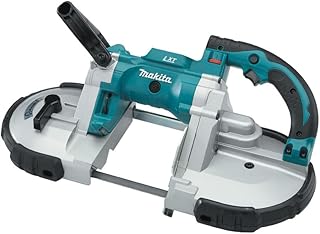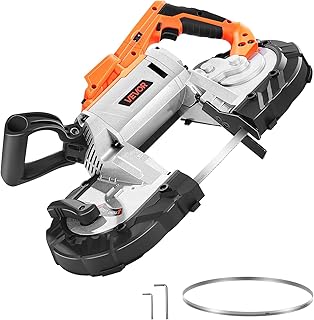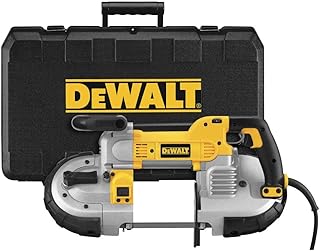When it comes to versatility and mobility, the best cordless band saw has become an essential tool for both hobbyists and professionals. Unlike stationary models, a cordless band saw offers freedom of movement without compromising cutting power. But with so many options on the market, how do you choose? Consider features found in the best home band saw for compact and precise cuts, or explore the best bandsaw under 1000 for budget-conscious yet high-performing options. For those seeking ultimate reliability, knowing what makes the best band saw stand out is key. Keep reading to uncover the top features, benefits, and insider tips that will help you select the ideal cordless band saw for your workshop or job site.
Top Picks
Best Cutting: MILWAUKEE'S Band Saw
The Milwaukee M18 Compact Band Saw stands out in the market for its combination of portability and cutting power. Weighing over 20% less than its predecessor, it is significantly easier to maneuver, making it ideal for jobs that require frequent repositioning or overhead work. Equipped with a POWERSTATE Brushless Motor and Constant Power Technology, this saw delivers faster, more consistent cuts through metal, outperforming many competitors in its class. Its compact design does not compromise on performance, allowing users to handle tight spaces efficiently while maintaining precision. The high-speed steel blade enhances durability and cutting efficiency, particularly for metal surfaces, making it a reliable tool for both professional and serious DIY users.
From a customer perspective, the lightweight and compact nature of the saw reduces fatigue during extended use, and the advanced motor technology ensures smooth operation even on demanding tasks. Some users note that relying on cordless power can be limiting during long projects unless spare batteries are available, and the premium price may be a consideration for budget-conscious buyers. Overall, those who prioritize cutting speed, maneuverability, and a durable build find this band saw an excellent investment for metalworking applications.
Best Portability: DEWALT 20V MAX Band Saw, 5" Cutting Capacity, Integrated Hang Hooks
The DEWALT DCS374 20V MAX* Band Saw is designed to deliver efficient, portable cutting for woodworking and light metal applications. At just 12.4 pounds, it is easy to handle and maneuver, making it ideal for overhead work or tight spaces. Its brushless motor improves efficiency and extends the tool’s lifespan while maintaining consistent cutting power. The compact design, combined with a 5-inch high-quality metal blade, allows for precision cuts on a variety of materials. Thermoplastic elastomer handles enhance comfort and grip, reducing user fatigue during extended use.
From a user perspective, the cordless battery system provides freedom from power cords, but the inclusion of only one battery can be limiting for longer projects, requiring additional purchases for continuous operation. Some users also note that the 5-inch blade is best suited for smaller-scale tasks and may not accommodate very thick materials. Overall, customers appreciate the portability, reliability, and performance of this band saw, especially for mobile or workshop settings where maneuverability and efficiency are top priorities.
Best Efficiency: DEWALT 20V MAX XR Bandsaw, Brushless Motor, Portable and Cordless
The DEWALT DCS378B 20V MAX* Band Saw is a lightweight, portable tool designed for efficient cutting of wood and similar materials. Weighing just under 11 pounds, it is easy to handle in tight spaces or for overhead work. The brushless motor delivers 570 RPM, ensuring fast, smooth, and consistent cuts while maximizing battery efficiency. Its 8-inch alloy steel blade with 24 teeth provides precise cutting performance, suitable for a variety of woodworking applications. The compact form factor and plastic handle design enhance user comfort and control, making it a practical option for both workshop and on-site tasks.
From a user perspective, the saw’s portability and cutting speed are standout features, making it ideal for professionals who need a reliable tool for quick, accurate cuts. However, since it is sold as a bare tool, buyers must provide their own 20V battery, which can add to the overall cost. Additionally, some users may find the single-battery requirement limiting during extended use. Overall, those who prioritize speed, maneuverability, and efficiency will find this band saw a highly effective addition to their toolkit.
FAQs
What is the 3-tooth rule for bandsaws?
The 3-tooth rule is a guideline for safe and efficient band saw cutting. It states that at least three teeth of the blade should always be in contact with the material being cut at any moment. This ensures smooth cutting, reduces the risk of blade binding or breakage, and prevents damage to both the material and the tool. Using a blade too fine or too coarse for the material can violate this rule, so matching tooth count to your cutting application is essential. For example, cutting thick metal requires a blade with fewer teeth per inch (TPI), while fine woodworking may use more TPI. Following the 3-tooth rule maximizes safety and prolongs blade life.
What is the difference between the M18 and M12 bandsaw?
The M18 and M12 are both cordless band saws from Milwaukee, but they differ significantly in power, size, and applications.
-
M18 Bandsaw: Uses an 18-volt battery, providing higher torque, faster cutting speeds, and the ability to handle thicker materials. Ideal for professional workshops and heavy-duty metal cutting tasks. The M18 often has larger cutting capacities and longer battery life, making it suitable for extended job site use.
-
M12 Bandsaw: Powered by a 12-volt battery, it is lighter, more compact, and better suited for smaller jobs or tight spaces. While less powerful than the M18, it excels in portability and ease of handling. It’s perfect for home projects, minor repairs, or when maneuverability is critical.
Choosing between the two depends on your workload, material type, and whether you prioritize power or portability.
What is the 4-inch rule for bandsaw?
The 4-inch rule refers to a common guideline for cutting stock with a band saw. It suggests that for blades under a certain size, the maximum thickness of material should be no more than four times the width of the blade. This rule helps prevent excessive blade deflection, ensures cleaner cuts, and minimizes the risk of accidents. For example, a 1-inch blade should not attempt to cut more than 4 inches of thick material in a single pass. Adhering to this rule maintains blade tension, improves accuracy, and extends blade life.
Are any bandsaws made in the USA?
Yes, several bandsaws are manufactured in the USA. Brands like Jet, Laguna Tools, Rikon, and Delta have models assembled or produced domestically. These American-made saws often emphasize quality engineering, durable components, and extensive warranties. Buying a U.S.-made bandsaw can be advantageous for supporting local manufacturing, ensuring easier access to replacement parts, and benefiting from customer service rooted in domestic operations. Always check the specifications, as some brands may source components internationally while assembling in the U.S.
Final Thoughts
Selecting the best cordless band saw requires balancing portability, power, and precision. Understanding guidelines like the 3-tooth and 4-inch rules ensures safe and effective cutting, while comparing options like the M18 and M12 models helps match the tool to your workload. For those seeking durable and reliable tools, considering U.S.-made bandsaws adds an extra layer of confidence. Whether for home workshops, professional jobs, or DIY projects, a quality cordless band saw enhances efficiency, convenience, and cutting accuracy, making it a worthy investment for any craftsman.






















